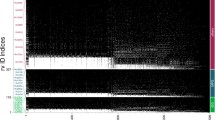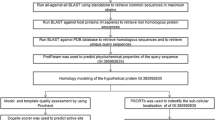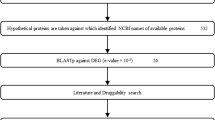Abstract
Extensive dead ends or host toxicity of the conventional approaches of drug development can be avoided by applying the in silico subtractive genomics approach in the designing of potential drug target against bacterial diseases. This study utilizes the advanced in silico genome subtraction methodology to design potential and pathogen specific drug targets against Mycobacterium tuberculosis, causal agent of deadly tuberculosis. The whole proteome of Mycobacterium tuberculosis F11 containing 3941 proteins have been analyzed through a series of subtraction methodologies to remove paralogous proteins and proteins that show extensive homology with human. The subsequent exclusion of these proteins ensured the absence of host cytotoxicity and cross reaction in the identified drug targets. The high stringency (expectation value 10−100) analysis of the remaining 2935 proteins against database of essential genes resulted in 274 proteins to be essential for Mycobacterium tuberculosis F11. Comparative analysis of the metabolic pathways of human and Mycobacterium tuberculosis F11 by KAAS at the KEGG server sorted out 20 unique metabolic pathways in Mycobacterium tuberculosis F11 that involve the participation of 30 essential proteins. Subcellular localization analysis of these 30 essential proteins revealed 7 proteins with outer membrane potentialities. All these proteins can be used as a potential therapeutic target against Mycobacterium tuberculosis F11 infection. 66 of the 274 essential proteins were uncharacterized (described as hypothetical) and functional classification of these proteins showed that they belonged to a wide variety of protein classes including zinc binding proteins, transferases, transmembrane proteins, other metal ion binding proteins, oxidoreductase, and primary active transporters etc. 2D and 3D structures of these 15 membrane associated proteins were predicted using PRED-TMBB and homology modeling by Swiss model workspace respectively. The identified drug targets are expected to be of great potential for designing novel anti-tuberculosis drugs and further screening of the compounds against these newly targets may result in discovery of novel therapeutic compounds that can be effective against Mycobacterium tuberculosis.
Similar content being viewed by others
References
Arnold, K., Bordoli, L., Kopp, J., Schwede, T. 2006. The SWISS-MODEL workspace: A web-based environment for protein structure homology modelling. Bioinformatics 22, 195–201.
Bagos, P.G., Liakopoulos, T.D., Spyropoulos, I.C., Hamodrakas, S.J. 2004. PRED-TMBB: A web server for predicting the topology of beta-barrel outer membrane proteins. Nucl Acid Res 32, W400–W404.
Bairoch, A., Apweiler, R. 2000. The SWISSPROT protein sequence database and its supplement TrEMBL in 2000. Nucl Acid Res 28, 45–48.
Cai, C.Z., Han, L.Y., Ji, Z.L., Chen, X., Chen, Y.Z. 2003. SVM-Prot: Web-based support vector machine software for functional classification of a protein from its primary sequence. Nucl Acid Res 31, 3692–3697.
Cole, S.T., Brosch, R., Parkhill, J., Garnier, T., Churcher, C., Harris, D., Gordon, S.V., Eiglmeier, K., Gas, S., Barry, C.E. 3rd, Tekaia, F., Badcock, K., Basham, D., Brown, D., Chillingworth, T., Connor, R., Davies, R., Devlin, K., Feltwell, T., Gentles, S., Hamlin, N., Holroyd, S., Hornsby, T., Jagels, K., Krogh, A., McLean, J., Moule, S., Murphy, L., Oliver, K., Osborne, J., Quail, M.A., Rajandream, M.A., Rogers, J., Rutter, S., Seeger, K., Skelton, J., Squares, R., Squares, S., Sulston, J.E., Taylor, K., Whitehead, S., Barrell, B.G. 1998. Deciphering the biology of Mycobacterium tuberculosis from the complete genome sequence. Nature 393, 537–544.
Dolin, P.J., Raviglione, M.C., Kochi, A. 1994. Global tuberculosis incidence and mortality during 1990-2000. Bull World Health Organ 72, 213–220.
Dutta, A., Singh, S.K., Ghosh, P., Mukherjee, R., Mitter, S., Bandyopadhyay, D. 2006. In silico identification of potential therapeutic targets in the human pathogen Helicobacter pylori. In Silico Biol 6, 43–47.
Gardy, J.L., Laird, M.R., Chen, F., Rey, S., Walsh, C.J., Ester, M., Brinkman, F.S. 2005. PSORTb v.2.0: Expanded prediction of bacterial protein subcellular localization and insights gained from comparative proteome analysis. Bioinformatics 21, 617–623.
Jasmer, R.M., Nahid, P., Hopewell, P.C. 2002. Clinical practice. Latent tuberculosis infection. N Engl J Med 347, 1860–1866.
Kumar, V., Abbas, A.K., Fausto, N., Mitchell, R.N. 2007. Robbins Basic Pathology. Saunders Elsevier, Philadelphia.
Lawn, S.D., Zumla, A.I. 2011. Tuberculosis. Lancet 378, 57–72.
Li, W., Godzik, A. 2006. Cd-hit: A fast program for clustering and comparing large sets of protein or nucleotide sequences. Bioinformatics 22, 1658–1659.
Maglott, D., Ostell, J., Pruitt, K.D., Tatusova, T. 2007. Entrez Gene: Gene-centered information at NCBI. Nucl Acid Res 35, D26–D31.
Miesel, L., Greene, J., Black, T.A. 2003. Genetic strategies for antibacterial drug discovery. Nat Rev Genet 4, 442–456.
Moriya, Y., Itoh, M., Okuda, S., Yoshizawa, A.C., Kanehisa, M. 2007. KAAS: An automatic genome annotation and pathway reconstruction server. Nucl Acid Res 35, W182–W185.
Neema, M., Karunasagar, I. 2011. In silico identification and characterization of novel drug targets and outer membrane proteins in the fish pathogen Edwardsiella tarda. Open Access Bioinformatics 3, 37–42.
Rathi, B., Sarangi, A.N., Trivedi, N. 2009. Genome subtraction for novel target definition in Salmonella typhi. Bioinformation 4, 143–150.
Sakharkar, K.R., Sakharkar, M.K., Chow, V.T. 2004. A novel genomics approach for the identification of drug targets in pathogens, with special reference to Pseudomonas aeruginosa. In Silico Biol 4, 355–360.
Sarangi, A.N., Aggarwal, R., Qamar, R., Nidhi, T. 2009. Subtractive genomics approach for in silico identification and characterization of novel drug targets in Neisseria Meningitides Serogroup B. J Comput Sci Syst Biol 2, 255–258.
Seltmann, G.H.O. 2002. The Bacterial Cell Wall. Springer Berlin, Heidelberg.
Szklarczyk, D., Franceschini, A., Kuhn, M., Simonovic, M., Roth, A., Minguez, P., Doerks, T., Stark, M., Muller, J., Bork, P., Jensen, L.J., von Mering, C. 2011. The STRING database in 2011: Functional interaction networks of proteins, globally integrated and scored. Nucl Acid Res 39, D561–D568.
Udwadia, Z.F., Amale, A.R., Ajbani, K.K., Rodrigues, C. 2011. Totally drug-resistant tuberculosis in India. Clin Infect Dis, doi: 10.1093/cid/cir889.
Victor, T.C., de Haas, P.E., Jordaan, A.M., van der Spuy, G.D., Richardson, M., van Soolingen, D., van Helden, P.D., Warren, R. 2004. Molecular characteristics and global spread of Mycobacterium tuberculosis with a western cape F11 genotype. J Clin Microbiol 42, 769–772.
Warren, R., Richardson, M., van der Spuy, G., Victor, T., Sampson, S., Beyers, N., van Helden, P. 1999. DNA fingerprinting and molecular epidemiology of tuberculosis: Use and interpretation in an epidemic setting. Electrophoresis 20, 1807–1812.
Warren, R.M., Streicher, E.M., Sampson, S.L., van der Spuy, G.D., Richardson, M., Nguyen, D., Behr, M.A., Victor, T.C., van Helden, P.D. 2002. Microevolution of the direct repeat region of Mycobacterium tuberculosis: Implications for interpretation of spoligotyping data. J Clin Microbiol 40, 4457–4465.
WHO (World Health Organization). 2010. Tuberculosis Fact sheet N°04.
WHO (World Health Organization). 2011. Global Tuberculosis Control.
Zhang, R., Ou, H.Y., Zhang, C.T. 2004. DEG: A database of essential genes. Nucl Acid Res 32, D271–D272.
Author information
Authors and Affiliations
Corresponding author
Rights and permissions
About this article
Cite this article
Hosen, M.I., Tanmoy, A.M., Mahbuba, DA. et al. Application of a subtractive genomics approach for in silico identification and characterization of novel drug targets in Mycobacterium tuberculosis F11. Interdiscip Sci Comput Life Sci 6, 48–56 (2014). https://doi.org/10.1007/s12539-014-0188-y
Received:
Revised:
Accepted:
Published:
Issue Date:
DOI: https://doi.org/10.1007/s12539-014-0188-y




